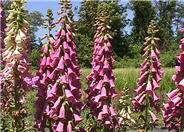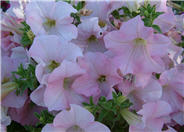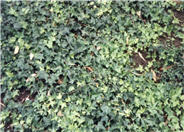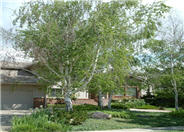
Common name:Common Foxglove
Botanical name:Digitalis purpurea
This biennial foxglove will reach up to 4' when blooming in the early summer. The large spire of huge, bell-shaped flowers ranges from purple to pink to cream with purple specks. Large, textured leaves form an attractive rosette until bloom time. The plant likes a moist, filtered-sun area similar to the Lobelias and Columbines. -Holland Wildflower Farm

Common name:Petunia
Botanical name:Petunia X hybrida
This plant will grow 1'-3' tall and has medium-sized green leaves with multi-colored flowers that bloom in spring and summer.

Common name:Hahn's Self-Branching Ivy
Botanical name:Hedera helix 'Hahns'
This vine takes on a more bushy form with branching at the tips; it produces amazing dark green leaves with insignificant small, white flowers. It will grow on fences, trees, walls and buildings. It can be used for topiaries, on hillsides for erosion control or for a lawn substitute. It tolerates full or part sun and is very hardy.

Common name:White Birch, European White Birch
Botanical name:Betula pendula
This medium-size weeping tree will grow to about 40' tall and has a whitish/brown bark with deciduous green leaves.

Common name:Tree Roses
Botanical name:Rosa Tree varieties
Tree roses are actually shrubs that have been grafted or grown in a way that looks like a tree, ie with a trunk. Tree roses can be floribundas, hybrid teas, or grandifloras. They are typically used as specimen plants. Make sure the plant is tied to a stake in case of strong winds.

Common name:Summer Lobelia
Botanical name:Lobelia erinus
This short ground cover has small green leaves with blue or red flowers that bloom in the summer and fall.
| Designer: Homeowner | Seating in Fairyland |
Photographer: GardenSoft |
Soils and Compost:
Incorporate compost 6" into your soil to retain water, reduce compaction, feed earthworms, and provide valuable nutrients to your plants.
Water Saving Tip:
Water-wise plants can be beautiful as well as practical.
Take your 'My List' Hydrozone Report to a landscape designer, or local nursery, when selecting and purchasing plants.
Integrated Pest Management:
Develop healthy soil for plants that are vigorous and naturally pest-resistant.

